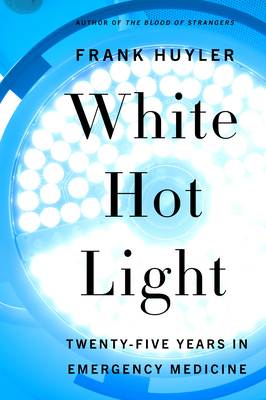
White Hot Light
Twenty-Five Years in Emergency Medicine
بیست و پنج سال در پزشکی اورژانس
کتاب های مرتبط
- اطلاعات
- نقد و بررسی
- دیدگاه کاربران
نقد و بررسی

May 18, 2020
Huyler (Right of Thirst) shares dramatic and often intimate glimpses into his life as an ER physician in this haunting collection of 16 essays. “The Boy,” the first essay, instantly grabs readers’ attention with the piercing sentence, “When they brought him in, he was almost alive.” This and other essays focus on a single case, as in “The Wedding Party,” where Huyler learns of an old classmate’s terminal lymphoma. Others, including “Jehovah” or “The Gun Show,” recall the seemingly endless series of patients Huyler has treated. A few essays peek into the bleak job of working in an ER. In “Mercy,” Huyler is surprised to see the tears of another attending physician, while “The Sunflower” explores the hospital at night, “purer at night than in the day... the sense of being left alone, where no one bothers you,” but with the caveat that “time falls upon you more heavily.” In “The Snow Storm,” Huyler delves into his identity as a son as well as a doctor, driving hours through the night to be at his hospitalized father’s side. Huyler’s compassionate perspective and gripping stories result in a memorable account of the life he leads and the patients he sees, and sometimes saves.

June 15, 2020
Tales from the emergency room, told with no-nonsense brevity, clarity, and compassion. In this long-awaited follow-up to The Blood of Strangers (1999), Huyler returns with more interesting, largely stand-alone stories from his work in an ER in Albuquerque. The author is a much-traveled chronicler who has also published two novels as well as poetry in the Atlantic and elsewhere, and at this stage of life, he displays a certain weariness and melancholy. However, this does not deter from the urgency to do the right thing. So Huyler recounts his lecture to the heroin addict he brought back to life and the process of suturing with painstaking care the facial slash that a man inflicted on his girlfriend with a broken beer bottle. Many of the emergencies the author encounters are truly life or death, and he marvels at a variety of medical advances--e.g., the CPR machine that revived a heart attack victim or the defibrillator that shocked the heart of a man just in time for him to be rushed to surgery. He also expounds on the remarkable nature of the human body. "In the deepest sense our lives are electrical currents," he writes. "Charged elements--sodium and potassium and countless others--flow back and forth across membranes with impossible complexity." Huyler enriches the text with sketches of his colleagues and of some of the patients who are ER regulars as well as anecdotes from a life growing up in foreign cities with his teacher parents. Throughout, the author pleasingly describes the various settings. "The winter sun in New Mexico is breathtaking," he writes. "Driving as it rises is dangerous here. If you let it, it will fill your windshield with white hot light, and blind you in the mirror with its power." The title aptly describes the illumination Huyler brings to patient care--and to writing about it.
COPYRIGHT(2020) Kirkus Reviews, ALL RIGHTS RESERVED.

July 1, 2020
Emergency departments are crucibles of casualties, lives saved, and chaos. In the ER, the banal mingles with the catastrophic. Emergency physician Huyler assembles 30 terse tales (with truncated titles like "Time," "The Motorcycle," and "Vertigo") portraying life in the ER. Some selections seem incomplete and unfinished?more like moments of introspection or character sketches than developed stories. Denouement is often omitted (maybe because the true resolution of a patient's visit sometimes occurs much later). These accounts feature mostly common reasons, pre-pandemic, for a visit to the ER: a kidney stone, broken bone, laceration, shortness of breath, seizure, gunshot wound, drug overdose, infection. Yet weird stuff happens too?a woman shows up after intentionally plunging a sewing needle into her heart. Huyler's writing can be grim and graphic: "Her left foot was a black and reeking cantaloupe-sized ball of flesh." Memory is found to be imperfect. Clarity, when present, remains partially clouded like an immature cataract. Pity, grace, cruelty, self-inflicted wounds, and fatherhood are important themes here. In the ER, futility and failure, rescue and resurrection are endlessly lurking and competing.(Reprinted with permission of Booklist, copyright 2020, American Library Association.)

October 30, 2020
MD Huyler first demonstrated his artistry with his book of vignettes The Blood of Strangers (1999), inviting readers into the day-to-day of the emergency room. Reprising this format with his newest collection, Huyler writes from his current frame of reference: a veteran doctor who has experienced difficulties both professionally and personally. The vignettes in this latest collection are short, strong, and sometimes unsettling. Some stories take us into Huyler's past and present personal life; some into the lives of his patients as he sees them either in the ER or in different units of the hospital. Similar to Michael Stein's Broke: Patients Talk about Money with Their Doctor, this work features patient stories combined with a personal account of a doctor in the field. Throughout, we learn about the hopes and fears of nurses working alongside Huyler, and we come to see that he defines himself, in part, by his work and his relationships with others. VERDICT Recommend reading for those interested in the human story behind emergency room medicine, both the stories of those who work in that field and the stories of those who need the services. Also recommended for those who enjoy personal essay collections. --Rachel M. Minkin, Michigan State Univ. Libs., East Lansing
Copyright 2020 Library Journal, LLC Used with permission.

























دیدگاه کاربران